Easy Homemade Ramen Bowls {Best Ramen Recipe}
Looking for the best Ramen recipe to make at home? These Easy Homemade Ramen Bowls let you make restaurant-worthy soup in the comfort of your own kitchen.
Table of Contents
About My Ramen Bowl Recipe
This easy and approachable homemade Ramen recipe remains a reader favorite after years of it being published. To be able to enjoy a big comforting bowl of your favorite Japanese soup in the comfort of your own home is some kind of bliss!
We aren’t all fortunate enough to have access to restaurants that offer this good stuff. So having this simple recipe up your sleeve is awesome.
What Is Ramen?
You’ve certainly heard people joke about Ramen being a food staple for broke college students. But today, Ramen joints are popping up in Western cities everywhere, attracting even the most haughty of food snobs.
So, what the heck is it—a meal for cheapskates or nosh for the posh? Both, really.
Traditionally, Ramen is a Japanese noodle soup made with a rich-flavored broth, then topped with an assortment of meats, vegetables, and a soft-boiled egg. In Japan, Ramen is dubbed a fast food and it’s made available in tiny restaurants and late night street carts.
But no matter where you’re slurping your Ramen, whether it be in a shoddy college dorm or that chic new Ramen bar in town, comfort is the name of the game with this coveted soup.
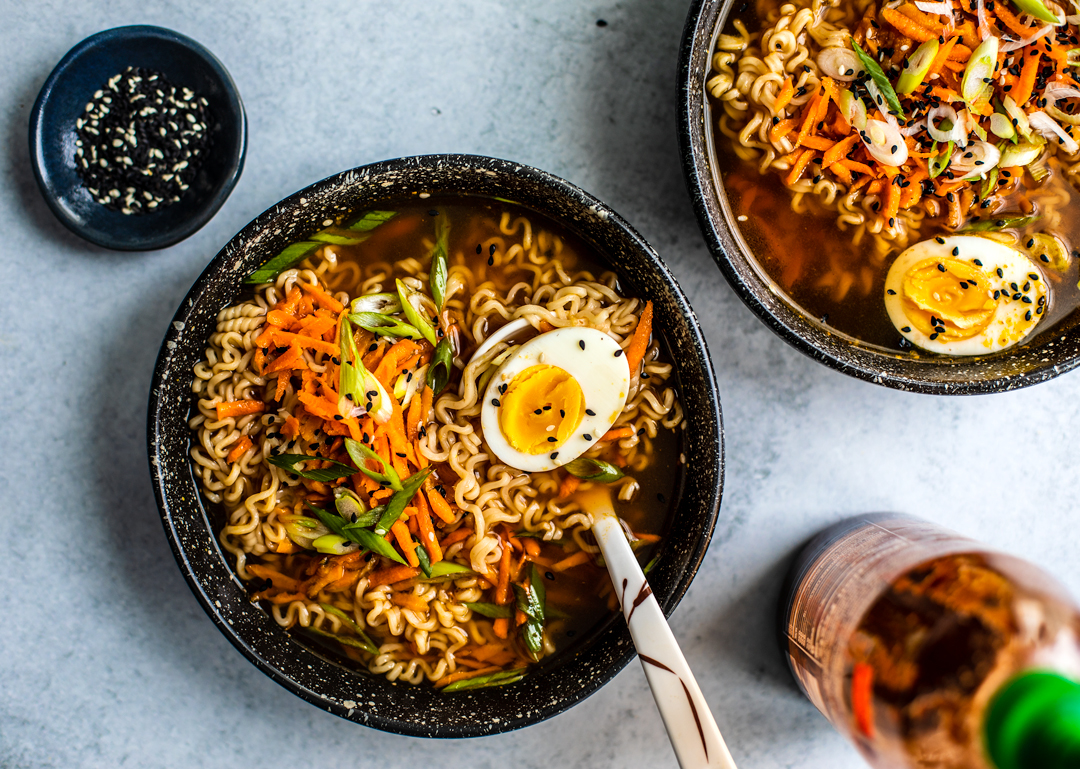
What Are Different Types of Ramen?
- Shoyu Ramen. This is the most common style of Ramen. Shoyu is the Japanese word for soy sauce, and that’s exactly what’s simmered into the base of this broth. The result is a light-bodied broth that is brown and clear, unlike the more milky and opaque tonkatsu broth. Intrigued? Check out my recipe for Spicy Shoyu Ramen.
- Shio Ramen. Another light broth—in both body and flavor—is shio, which means salt. This simple broth is golden in color and is made up of chicken or fish bones.
- Miso Ramen. If you’ve had miso soup, then you’re familiar with this cloudy and complex broth. Made with fermented soy bean paste, miso can be white or red in color. The broth is packed with umami and feels thicker on the palate than the lighter broths used for shio or shoyu broths. If this sounds good to you, check out my Miso Ramen.
- Tonkotsu Ramen. Full-bodied, fatty, and satisfying, the tonkotsu broth is the richest of them all. It’s made up of simmered pork bones which break down during the cooking process and release collagen, which makes a broth so thick it’ll coat the back of your spoon! The broth is often fortified with pork or chicken fat. So if you’re ordering yourself some Tonkotsu Ramen from a menu, know that you’re in for an indulgent treat.
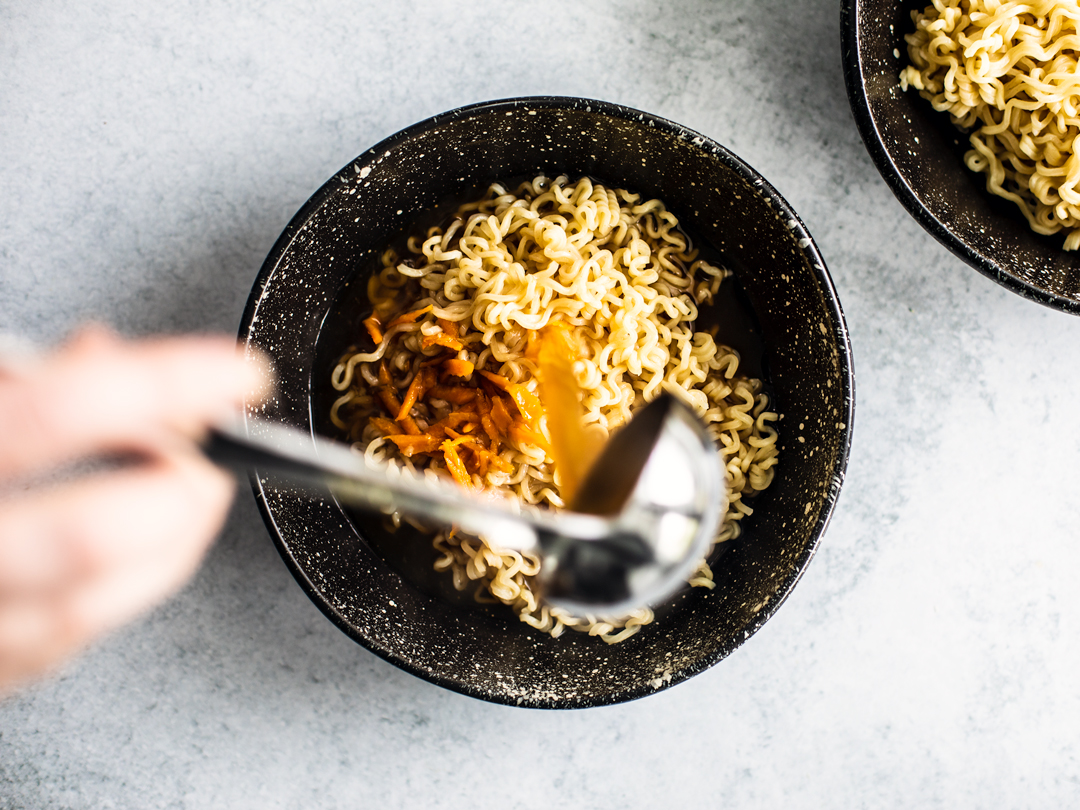
Ingredients
- Sesame oil
- Olive oil (or avocado oil)
- Garlic
- Fresh ginger
- Chicken or vegetable broth
- Rice vinegar
- Low sodium soy sauce
- Sriracha or hot chili garlic sauce, like Sambal Oelek
- Shredded carrots
- Shiitake mushrooms (optional)
- Scallions
- Sesame seeds
- Soft-boiled egg
Other Fun Toppings to Include
- Narutomaki (fish cakes; you’ve likely seen them. They’re the thinly-sliced rounds with pink spirals in the middle)
- Enoki mushrooms
- Nori (dried seaweed)
- Bamboo shoots
- Bean sprouts
- Corn kernels
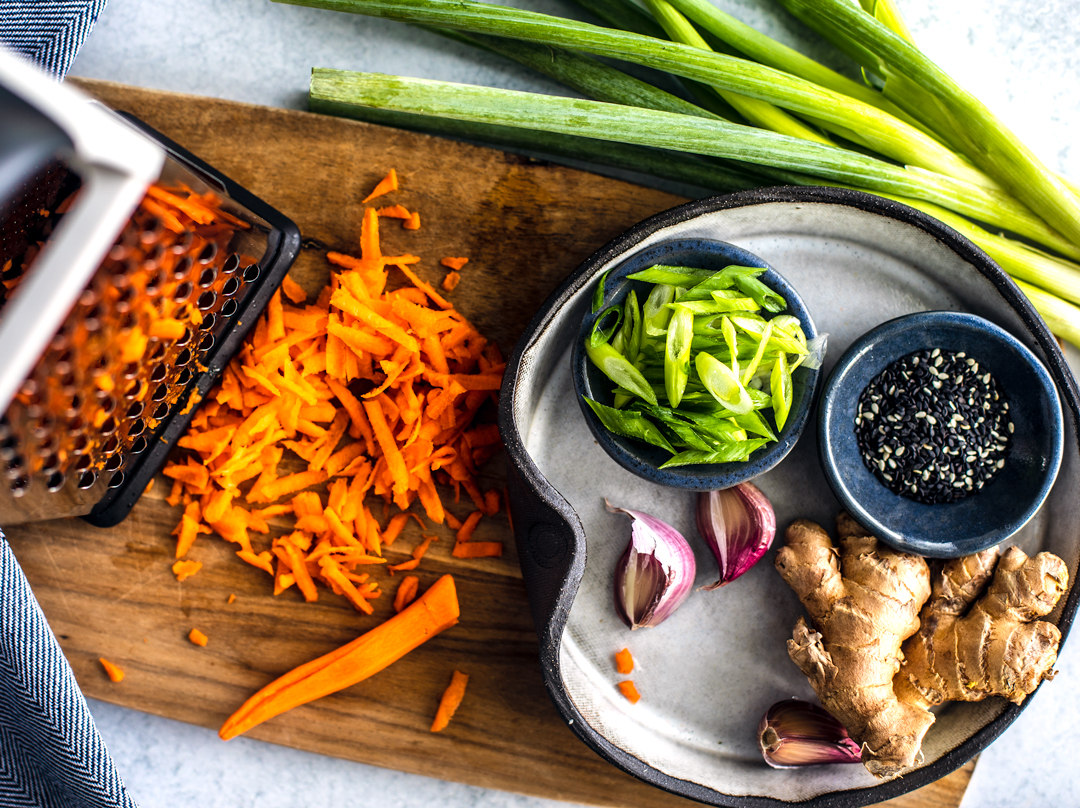
How to Make This Ramen Recipe
- Heat the oil in a medium-sized saucepan over medium heat. Once the oil is hot, you’ll add the garlic and ginger, and simmer until fragrant.
- Add the rest of the veggies you want to cook—in this recipe, the carrots and mushrooms—and cook them until they soften up.
- Transfer the broth to the pot and add the rice vinegar, soy sauce, and Sriracha. Give the broth a good stir to combine the ingredients.
- Let the soup simmer for about five minutes, then give it a taste and add more soy sauce or Sriracha if needed. (This depends on how salty and spicy you want it.)
- While the soup simmers, cook the Ramen noodles in a separate pot as per the packages instructions.
- When done, drain, rinse under cool water, place into your soup bowl, and set aside.
- Once the broth is ready, spoon it over the noodles, then garnish the bowl with whatever you please!
How to Make a Ramen Egg
- Bring a small pot of water to a boil, add the egg, and time it for five minutes.
- While the egg is boiling, get an ice bath ready in a bowl big enough to cover the egg.
- When the egg is ready, carefully transfer it from the boiling water to the ice bath and let it cool for about a minute. (The ice bath prevents the egg from cooking further once removed from the hot pot.)
- Finally, lightly crack and roll the egg on a cutting board, peel it, and slice it in half.
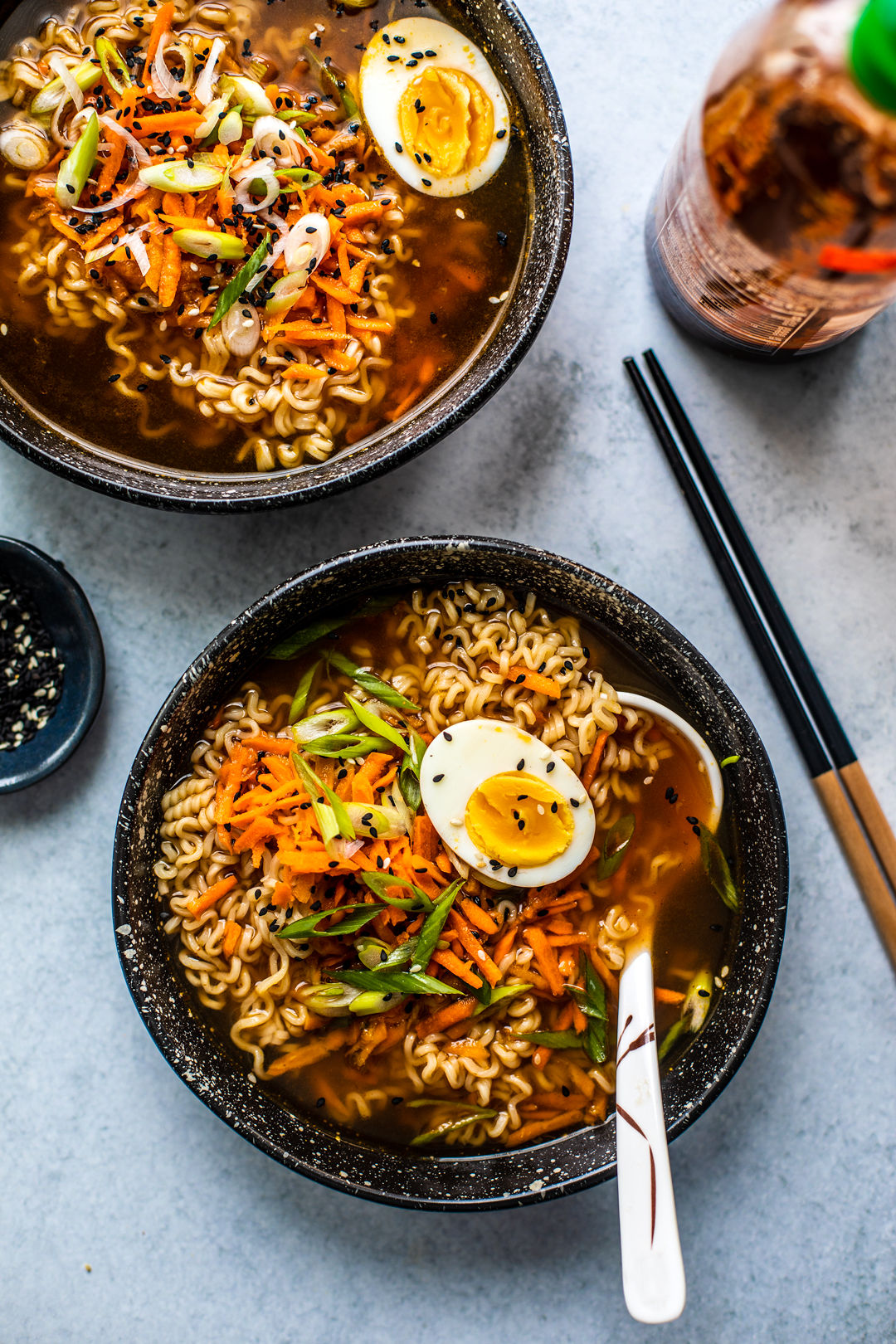
Ramen Bowl Essentials
- Japanese Style Ramen Bowl
- Chopsticks
- Wonton soup spoon, the best way to slurp up that homemade Ramen broth.
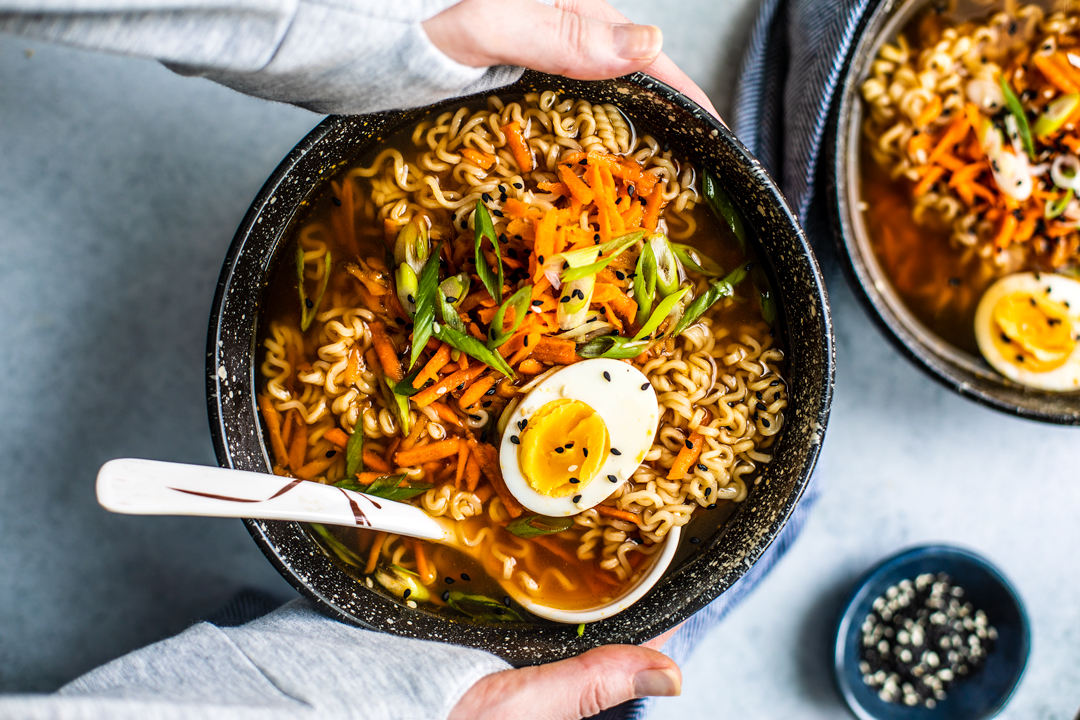
More Ramen Soup Recipe to Try at Home
Have You Made This Recipe?
If you enjoyed this recipe, please consider leaving a STAR rating & commenting below with feedback!
You can also show off your creations on Instagram by tagging @killing__thyme
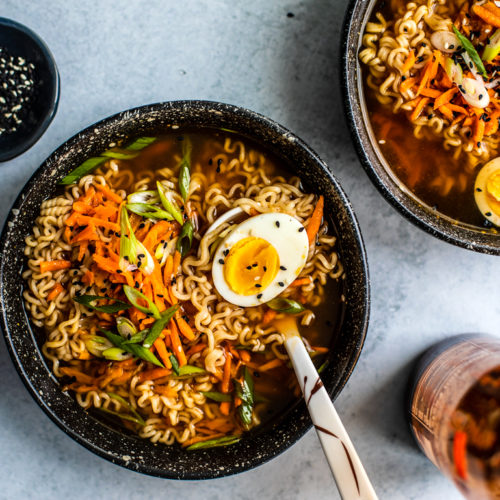
Easy Homemade Ramen Bowls
Ingredients
- 1 tsp sesame oil
- 1 tsp olive oil
- 2 cloves garlic, minced
- 2 tsp freshly grated ginger
- 1/2 cup shredded carrots
- 1/2 cup shiitake mushrooms, sliced (optional)
- 4 cups Chicken or vegetable broth
- 1 TBSP rice vinegar
- 3 TBSP low-sodium soy sauce (more to taste)
- 1 TBSP Sriracha sauce (more or less, depending on your heat tolerance)
- 2 3 oz portions of Ramen (discard the flavor packets)
Toppings
- Sliced scallions
- Sesame seeds
- Shredded carrots
- Soft-boiled egg
Instructions
- Heat sesame oil and olive oil in a medium-large saucepan over moderate heat (see notes). Add garlic and ginger, and simmer until fragrant, about 2-3 minutes. Do not brown the garlic, or else you'll get a bitter flavor.
- Add the carrots and mushrooms if you’re using them, and simmer until they soften, about a minute, stirring frequently.
- Add the broth, Sriracha sauce, rice vinegar, and soy sauce. Stir, and bring to a simmer; let it go for about five minutes. Taste, and adjust heat and taste to your liking by adding more Sriracha and soy sauce if needed.
- While the broth simmers, cook the Ramen noodles in a separate pot as per the package's instructions. (You could cook the noodles in the broth directly, but that makes for a messy transfer to a bowl. It's much easier to transfer drained cooked noodles to a bowl and spoon the broth over top.) Once the noodles are tender, drain and rinse under cool water, place into a soup bowl, and set aside.
- When the soup is ready, spoon the broth over the noodles. Allow to cool. At this point, make your soft-boiled egg if you're garnishing with one, and add the rest of your toppings to serve.
Soft-Boiled Egg
- Bring water to a boil in a small saucepan. Add the egg(s), and let them boil for five minutes. In the meantime, prepare an ice bath in a bowl. Once five minutes are up, remove the egg(s) and dunk them into the ice bath for about a minute to cool them off enough to handle. Then, lightly crack and roll them on a flat surface, peel, slice in half, and place on top of your Ramen.

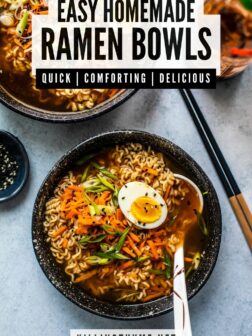
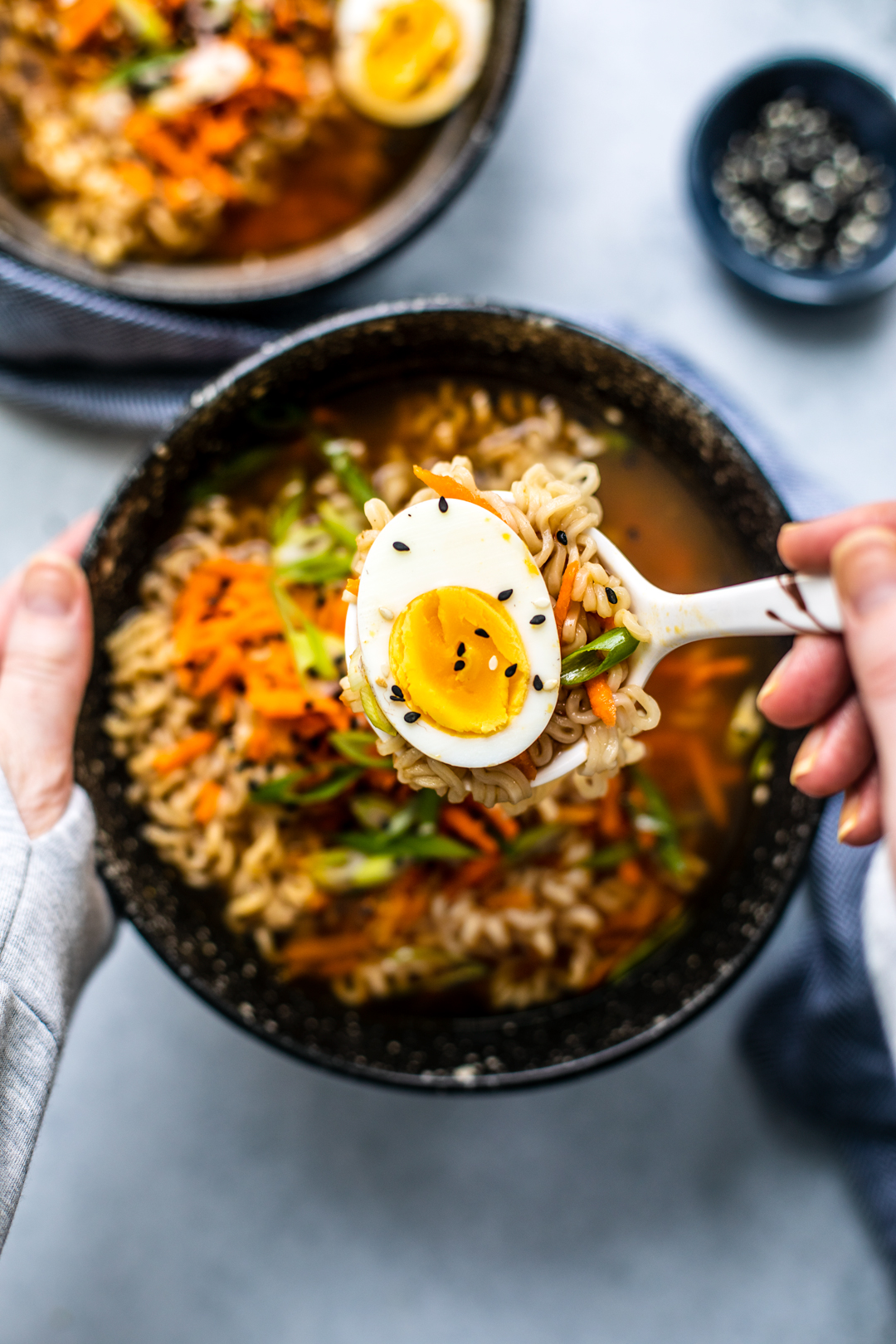


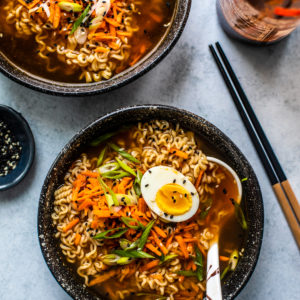










307 Comments on “Easy Homemade Ramen Bowls {Best Ramen Recipe}”
I’d like to prepare this so it can be taken to work throughout the week. There’s access to an electric kettle and microwave. Can you suggest how one could prep this ahead?
For example I’m thinking I could make the broth and portion it out. Make the eggs ahead and let the reheated broth warm it through.
What recommendations do you have?
Hi! So, yes. That’s exactly how I’d do things. Prepare the broth at home, as well as the eggs, and pop the eggs into the broth once its reheated. Let them sit in there while you cook the noodles separately. Then once you transfer the noodles to the bowl, the eggs will be warmed and good to go :)
Let me know how it goes!
These were better than restaurant quality. I love that I could control the flavors in each one so that even the kids could enjoy them!
These bowls were amazing. All my favourite flavours and so easy to make.
The family and I had fun making this ramen over the weekend. It was the perfect warm and cozy dinner!
I love this recipe! It is so flavorful and easy to make! Thanks for sharing!
I love ramen – REAL ramen. I made this last night for the family, and it was so good. There’s just nothing like homemade ramen.
yummy!! loved it so easy!
Delish! I followed the recipe exactly aside from adding snow peas and using Udon noodles instead of ramen. This will definitely become part of the regular dinner rotation for winter
Thank you for this incredible recipe!
But I’ve got to ask, where are the bowls in your pictures from?
I’d love a set of my own!
Hi Terri! I’m so glad you enjoyed this. Also, happy you asked about the bowls. I could nerd out about pretty dishes all day ;) Believe it or not, I got these from Amazon! They are these bowls right here. I’ve had mine (I have the white ones also) since 2020 and they are still in perfect condition. I have some of their larger serving plates as well. Fantastic brand! Let me know if you get some, would love to see what you pick out. I just went to their page again and it looks like they have some new beautiful pieces in stock! Must resist…
Made this tonight — added some snow peas, edamame, and the whites of the scallions that I was using the greens of for garnish. Holy smokes, this recipe is a big hit in my house. And as an added bonus, I hadn’t prepped anything in advance, and it only took me 45 minutes to go from walking in the door to sitting down for dinner. This is definitely going into the last-minute dinner rotation. Thanks for a great recipe!
First time making this and it is absolutely amazing and super easy. Can’t wait to try the next one.
I don’t even know how many times I’ve made this recipe so far. It’s an easy, yet delicious way to scratch that ramen craving itch when you can’t get out to a restaurant.
Easy to make & delicious to eat
So glad you enjoyed it, Miki!
This Best Ramen Recipe is simply amazing. The flavors are rich and satisfying, and the homemade broth is out of this world. I could eat this ramen every day!
The comfort of knowing that I can enjoy a comforting bowl of ramen without having to dine out is reassuring. Plus, the process of preparing the soup from scratch allows for a deeper connection with the food I’m preparing, adding an extra layer of enjoyment to the dining experience.
This was everything a gourmet meal should be, and then some! Easy, hearty and delicious; my whole family loved it!
My family loves ramen and this was so fun and easy to make at home!
Pingback: Shoyu Ramen Recipe - Killing Thyme
Pingback: Curry Pumpkin Cauliflower Soup - Killing Thyme
My roommate and I have tried a few ramen recipes online but we keep coming back to yours. This one, and the one with curry and chicken. Amazing! We’re going to try your miso ramen and shoyu ramen soon. Thanks for the awesome recipes. We love making these at home!
This makes me happy, Jenna. Thank you! Keep me posted on the other two you try!
So simple and Delicious!
Thank you :)
Made this for dinner tonight. Quick, easy and very flavorful. My husband loved it, I did not have shiitake mushrooms I just added regular small button mushrooms, shredded carrots and half a red bell pepper. Added about a teaspoon to two teaspoons of garlic chili oil after serving and it complemented the soup very well. Thank you for such a well written blog and a wonderful, easy, and delicious recipe!!
Sounds delicious! Thanks so much for your feedback, Noura.
Pingback: How to Microwave Ramen Like a Pro | EverestHimalayanCuisine
Pingback: Meal Plan Week 9
Easy and delicious!
That’s the goal and really, the perfect meal, right!?
Thanks for the feedback :)
Excellent recipe!! It tasted just like my favorite Korean store bought ramen! I used vermicelli instead of ramen noodles and it turned out really good. Thanks for sharing!
I’m so glad you loved it!
I made this today, and it was delicious!! Thanks for sharing the recipe, I will make this definitely again.
Happy to hear it! :)
Simple and delicious. Couldn’t find shiitake mushrooms so used enoki instead. Very easy recipe. Even the toddler demolished it.
I wish my toddler would demolish this! He’s still noodles and broth only. One day! I’m so glad you guys enjoyed it :)
This is delicious! I added some chicken to mine. Followed the recipe exactly other than that.
Awesome! I love to add chicken once in a while too.
This soup is delicious and a family favourite. Sometimes we add pieces of rotisserie chicken to boost up the protein. Either way, it’s a hit!
Love adding chicken! And rotisserie is so convenient. Glad you enjoyed it!
So easy to make and tastes delicious
Thanks, Michele!
Always looking for ways to dress up my ramen and make it a little better. This was perfect! So tasty. Looking forward to making it again.
Thanks, Justine! I’m so glad!
I never knew there were so many different types of ramen! This homemade version is so much healthier than the instant ones I ate in college. I’m looking forward to experimenting with the different topping options.
Oh yeah, SO many varieties!
YUM! We loved making our own ramen bowls at home. They were easy, so comforting and I love how customizable they were. Great recipe!!
So happy you all had fun with these!
I love this soup. can’t wait to make this amazing recipe again.
Awesome!
Soooo good, quick & easy! Have been making it weekly. 1/2 T sriracha is all I need – still plenty of heat!
So glad you’re loving this, Cheryl! And yeah, I do like to go a little bananas with my heat. I’m glad you’ve been able to find your sweet spot with the Sriracha :)
This was delicious!
Thank you!
This is a great take on traditional Ramen. I tried this recipe with fried eggs and it was delicious.
I appreciate it, Anne! Glad it worked well with fried eggs. I’ll have to try that!
These bowls are beautiful. I’ve actually never attempted ramen before but now I feel like I can actually give it a shot!
I hope you do!
I love a good noodle bowl and this one did not disappoint! Can’t wait to make it again!
Yay!
These were incredible. Such a good way to use up leftovers too.
Thanks, Dannii!
That looks gorgeous and so easy too. Loving it 😍
Thanks!
I am a teenage girl who has quite a small family, but I’m always looking for easy and yummy things to make for nights when my mom is tired. This was super easy to make even for a younger person like me! I took out the mushrooms, and it still tasted amazing. I personally never liked runny egg yolk so next time I’m going to scramble the eggs and add them. I also want to make it with shrimp, I think that will taste very good…aaand one day chicken as well haha. The only thing I’d say is that I doubled the portion size and probably shouldn’t have as we have quite a bit of leftover soup, so the normal portion size is probably perfect for a 3-4 member family if you don’t want leftovers of the soup. However, if you’re server 5 or more people then doubling the recipe is a good idea. It all depends how hungry people are, how much they’ll eat, and how many leftovers you want! Very happy with how it came out :)
This is so sweet for you to do for your mom. Such a good idea! That’s all ☺️
I hope my kiddo is as sweet as you when he grows up! Showing up for your tired mama like that is amazing. She did well in raising you :) Thanks so much for the comment, Alaina!
This was an incredible ramen bowl. Totally upped the game. Thank you for an awesome recipe!
You’re so welcome!
My family loves this recipe.
Happy to hear it!
I made this at the beginning of the week! I’m glad I made more than t needed. I have been eating it all week it’s that good and filling. Tonight my son and his girlfriend are coming for supper and I am making a new batch! Love it!!
I hope they love it too, Jeanine!
I made this in the slowcooker, I added all the soup ingredients except the vegetable oil and noodles into the crock pot raw and I added a small thinly sliced onion and a large chicken breast cut into 6 or 7 pieces. I cooked it on high for 3.5 hours then shredded all the chicken and put it back in. Then I cooked the eggs and noodles as directed and served. This was AMAZING. My entire family including my picky teen and my husband who hates soup, LOVED this and want me to make it more often lol. Incredible. This may replace typical chicken noodle soup as my go to comfort soup. That said I cooked the eggs one more minute than directed and they were very runny. We prefer a bit more cook on ours so when getting ready to have leftovers I put the egg in at the beginning while bringing the water to a boil then cooked it for the 5 minutes after it started boiling, it came out with the texture I love (halfway between runny and hard boiled). Also I boil the eggs and noodles together in the same pot cause it saves dishes :)
I’m so glad this worked in a slow cooker! Great adaptation. Thanks for taking the time to explain everything you did here in case anyone else wants to try it in the slow cooker :)
I used shimeji mushrooms , cuz we dont have other ones here, and it still ended up really good, love the recipe thank you very much ♡ this was my first homemade ramen experience and you made it amazing 🤩
I’m so happy to hear it, Sarah! Shimeji mushrooms would be perfect—great choice!
This was sooo good! such an easy way to take ramen to the next level. Loved it!
So glad you enjoyed it, Liz!
I don’t understand. I followed the recipe exactly as listed and it came out terrible. We ended up throwing it out. I’m so upset we wasted the ingredients and time for this.
Hi Jennifer,
This is clearly a first. Sorry to hear something went wrong. If there’s anyway I can help you figure out what that is, please reach out!
Something tells me this was a “user error” and not the recipe.
This is an excellent review, I especially appreciate the points on how to up the nutritional content of Ramen. Another great add-on is kimchi! Thanks for the advice also on ditching the packet and adding our own broth, mushrooms, an added egg and even lentils are a great way to add plant-based protein.
Love kimchi! And yes, from-scratch broth is where it’s at. So glad you enjoyed this, Amber!
Made this for my word traveller son for his 31 birthday. We last had ramen in a crazy small place in Berlin. This recipe was PERFECT!!! We doubled it for 4 people but didn’t double the siracha. We also added sliced chicken barbecued with sesame oil, soy sauce and garlic. It was AMAZING – restaurant quality ramen!!! Don’t skip the egg or the other toppings. Thanks for an amazing recipe!!! We will def make again and again!
This is such a lovely comment, Sandy. Thank you SO much! The way you speak of your world experiences with food makes this that much more meaningful! I really appreciate you taking the time to stop in and let me know you all enjoyed this :)
So good! Was my first attempt at homemade Ramen and will definitely be making this again. Not too many ingredients and easy to follow instructions. The soft cooked egg was perfect addition. Also added some thinly sliced rare steak to the bowl before adding hot broth. Broth would also be great with seafood added… idea for next time. Thanks!
Happy to hear it, Pam! The egg is always my favorite part ;)
Love it!
Thank you, Blanca!
I made this with homemade chicken stock and used shredded chicken from the stock. I also added Mung bean sprouts because I had them and used my own measurements. It was amazingly delicious! Don’t forget lime juice.
Sounds awesome!
I made my own chicken stock and used some of the chicken instead of the egg just because I had it ! Delicious dish and now I have enough broth and chicken for leftovers!
The leftovers are just as good, too! :)
I’ve made this twice… and it was so good everyone wanted more. I’m planning on trying to can it, so we can have some on hand whenever we feel the need. I’ll let you know how it works out. If it does work, I’ll share the process if you want to share it with others.
I’m so glad everyone loved it, Laurel!
I made this last night & it was delicious. It will be on the regular rotation! I followed the recipe and added snap peas & green onion.
Love the addition of snap peas! And green onion is a must :)
I used homemade chicken broth and Ocean’s Halo Organic Noodles which is made with only wheat, water, and sea salt. I reduced soy sauce to 1 tablespoon.
Sounds great!
Delicious, rich broth. Will definitely make this again! Used baby bella mushrooms because I do not like shiitake, but it missed the umami, so we added the Trader Joe’s spice to it. Also added tofu for protein.
Great adaptations!
I’ve made this twice now. It’s so good! Both my father and I really enjoyed it. He said he could eat this every week.
I love this! :)
I made the dish. It was great.
Thanks!
This was so tasty. I had made my own in the past but this one is really flavorful. I didn’t have mushrooms so I omitted it was still amazing. I will definitely make this again.
Happy to hear it, Kathy!
Very good, but my chicken broth was super salty. Added some water and 2% milk. Yum. More of a brown broth than clear, but delish. A keeper and I’m a picky cook. Thanks for sharing.
Certain brands are definitely richer in sodium. I’m glad you were able to fix it!
Simple and great tasting! I will definitely use it again.
Thanks Eric! I’m so glad you enjoyed :)
This homemade ramen bowls is such a perfect recipe that we really enjoyed. And you have described everything so nicely that really helped.
I’m so glad, Zazyyed!
This as total comfort food, and so easy to make too.
100%!
I’m excited to try this flavor packed and comforting homemade ramen.
Excited for you to try them!
I make these ramen bowls for dinner ALL the time and my family just loves them!
Amazing!
Thank you so much! The flavors are perfect and I can’t wait to try this recipe!
Can’t wait to hear what you think!
This is a bowl of joy! So many great flavors together. Yum!
A bowl of joy: perfect description! :)
This was delicious! I love finding new ramen recipes and I already had all the ingredients except the mushrooms.
That’s perfect! I love when that happens. So glad you enjoyed it, Jen.
Thanks for sharing! Does it keep long?
You’re welcome! The broth keeps for about 3 days, but I wouldn’t store it with the noodles in it. I’d cook them once you’re ready to heat up the broth or else they’ll soak up all the broth and become soggy.
This looks so good! What a great weeknight meal or one to make for company!
Thank you! :)
Honestly, surprisingly complex flavours for a simple dish. Added lots of green and yellow onion, as well as spinach and celery’s to the recipe, and turned out great. Thanks for the quick dinner!
You’re so welcome!
Looks so tasty, and definitely agree so much better making your own broth and loading up the additions, too!
Yes! :)
Sooooo good.
After the scamdemic, the noodle place in town had to shut down. Thank you for bringing light into the darkness. Really appreciate this light and easy weeknight dish.
I’m so glad this recipe offered some comfort in a dark time :) It’s comments like these that make my day!
Used the recipe for the ramen broth only and added an over easy egg, cut bacon and scallions and it was amazing! Cut the siracha in half. Partner kept saying how delicious it was and that I should make it more often!
Awesome to hear, Anne! Glad you were able to make the recipe your own :)
This was so easy and so delicious! It’s a great alternative to my usual take out.
Very happy to hear this!
I love a good ramen recipe! This looks delicious and I can’t wait to try!
Keep me posted!
What magnificent flavors in this Homemade Ramen Bowl. I am looking forward to making this for my family again.
Excellent!
This is the best homemade ramen I’ve had! So many great ingredients, and vastly superior to what you get with the flavor packets. I’ll be using this recipe from now on!
Oh yeah, to hell with those flavor packets haha ;)
I have Ramen Noodles in my pantry right now. My children love them and wanted to eat them growing up. The egg just makes the dish complete.
I agree!
I’ve tried a few ramen recipes from online and this is my favorite one!
I’m so happy to hear this, Phoebe! Thank you!
Very informative article of ramen and beautiful pictures.
Thank you so much!
Thank you, Shu-Chun!
I just made this and thoroughly enjoyed it.
What’s the best way to store it? Together or separate?
Thank you
Hi Katie! I would store the broth separately to avoid noodles getting mushy :)
Hope that helps! So glad you enjoyed it.
Amazing! Very easy and flexible recipe. I did not have Ramen noodles, so I separately boiled lo mein noodles, and threw some leftover barbecue pork on top. Great mix of flavors! Definitely taste the sauce before you finish it. Mine was just missing a little bit of depth, so I added 1–2 teaspoons of fish sauce. Turned out beautifully!
So glad you enjoyed it, Caroline! Love your adaptations.
My family loved this-even without meat which my husband was worried about. I added bean sprouts and bok choy for more crunch and mouth feel. Huge hit! I’m making it again tonight but am thinking of adding meat. My husband thinks pork would be good. Have you made it with any meat? How’d it turn out? Thanks!
Hi Kati! So glad this was a hit. I’ve definitely made it with meat before and it’s great—just more filling! I’ve shredded rotisserie chicken and added it, and I’ve done it with shrimp. Let me know how it goes for you!
The taste was great and i enjoyed a lot
I’m so glad :)
one of my favorite recipes of all time
Thank you!
My 17 yo daughter suggested we do a hands on dinner meal so we came across this. We did this recipe with beef broth and some finely shaved beef and it was delicious. We added bean sprouts, chopped green onions and cilantro to top it all off.
Love your adaptations! And love that you got to spend some quality time with your daughter while making this :)
I just made this. Yesterday it was 82 degrees outside but now its 60 and rainy. Perfect soup for dinner. I used brown rice ramen noodles that I simmered in chicken broth. In our bowls I layered raw baby spinach, tender broccoli pieces, carrots julienned, sliced chicken thighs, mushrooms, ramen noodles, tofu cubes, scallions, sunflower shoots and steaming hot broth. I put minimal amount of noodles in mine but cut up some steamed cauliflower for a lower carb meal.
Great adaptations, Peggy! So glad you enjoyed it.
Truly appreciate the way you made this delicious recipe. Everything is so nicely described that really helped me.
I’m so happy to hear this, Ripon! Thank you for taking the time to leave feedback :)
This has become my go-to rainy day soup! Or sick day soup, and I spice it up a little extra.
It’s perfect for rainy and sick days! Spice it up enough and it’ll really knock it outta ya :)
Thank you so much for creating such a bomb ramen recipe that can easily be made at home! This is my sixth time making it and I figured it was time I leave a rating and comment :)
Sixth! I love it! That’s amazing. Thanks, Darcie :)
I’m doing a personal cooking challenge and your ramen dish was tasty! I wrote an article about your dish here.
https://marychang-10894.medium.com/homestyle-ramen-4b0e9a6d4774?sk=0f2235715b81fbc8e966bcb40d351803
Thanks Mary! Good luck with the challenge, that’s so fun! :)
Absolutely delicious! Super easy to make, I’ve made this a bunch of times!
So happy to head this, Maddie :)
I’ve made this recipe several times already, and each time it’s a hit! Love the simplicity and versatility of it: once I made it with mushrooms, once with peppers etc. Basically any veggie goes. As well as pretty much any asian-style noodles.
Thank you for this gem!
I’m so happy to hear this, Esya!
Could I use beef broth instead of chicken broth?? I’ve tried it with chicken broth but I’m curious if beef broth would be good too
Hi Alex! You could definitely try it out with beef broth. You’d get a much beefier flavor profile of course, but it could work! I’d be curious to see how it turns out. Please let me know if you try it :)
Yum!
:)
I made this recipe and loved it. I added thin sliced pork tenderloin, because I had it, and it was excellent.
Sounds like a delicious addition!
Your ramen bowl looks so colorful & irresistible.
Thanks!
Ramen perfection! I love all the great flavors in this. Can’t wait to give it a try!
Keep me posted!
This is really easy! So good and delicious, perfect for weeknights!
Thanks, Toni!
Everyone loved this ramen! I skipped the sriracha for the little ones and it was still delicious. This one’s a keeper!
Oh yes, the spice is optional thankfully. I’m really glad it was a hit!
Loved this recipe! Such a great quick dinner option for us! Shiitake is our favourite mushroom ever, so definitely recommend this! Will make again! :)
Awesome to hear!
Nothing like this ramen bowl to end the day.
Agreed ;)
A family favorite in our home! Amazing flavor!
Happy to hear it!
Made this yesterday and making it for dinner again tonight! This is such a great ramen recipe!
I’m so glad you enjoyed it, Jaella!
Been making this once a week for over a month so I figured it was time I left a review! I love spicy so I’ve been adding extra Sriracha and it’s so so good. Such an amazing broth. I could just drink that! I love how hearty this is without even needing meat.
Mirabelle! Thanks so much for taking the time to comment. I really appreciate it. Extra Sriracha sounds perfect :)
I love making my own spice mixes and it’s easy once you start. My own “usual suspects” are onion pwdr, garlic pwdr, 5 pepper mix, cayenne pepper, smoked paprika, Morton salt.
Very rarely until recently, I have to switch out the cayenne for the regular black pepper because my Northern grands can’t handle much heat. But I’m getting them there.
So ramen noodles in still teaching my sin how to make them with bone broth made from all sorts of pieces, like pork trotters or the succulent bone from a country ham.
Slow going but it’s a worthwhile journey!
Sounds like a labor of love!
I have made this many times now and the my kids, wife and myself LOVE this meal. And not just us, we have made it for family and friends and it’s always a big hit. Pork goes well with it if you are looking for meat to add. Thanks so much for sharing this recipe!!
Don! This makes me so happy. Thanks so much for taking the time to leave feedback. I bet throwing some pork to the mix makes it even better! Can’t deny the flavor from fatty meats. I’ll have to do that the next time I make it :)
Super delish and great to make with my ramen-loving teenage son. We did not have low sodium soy but the results tasted great. We used Dynasty Maifun rice stick noodles which worked out perfectly.
What a fun thing to do with your son! I can’t wait to do the same with mine. He’s 2.5 so he helps as much as he can ;)
I’ll have to try it with the rice stick noodles you mentioned! Thanks so much for popping in with feedback :)
This was delicious. I also added bok choy and spinach for more veggies and tofu.
I love the addition of bok choy! It’s so perfect in soup. Also love that you used tofu. Thanks for popping in with feedback :)
I love how easy and delicious this is!! Perfect for chilly nights!
Nothing better on a chilly evening!
Wow what an awesomely delicious lunch this made and it was so easy!
Happy to hear it, Claudia!
This is surely a bowl full of deliciousness.
Thank you!
Ramen is just so perfect for the weather! Would love to try this soon! Thank you so much for sharing this recipe!
Keep me posted, Maria :)
We’ve been getting some wonderfully cool and crisp days here in the South, totally appropriate for this!
This is total comfort food for me. So easy to make too.
Super easy!
Oh, I didn’t know making Ramen is so easy – and I just realized I have everything at home, just need to get the noodles, nomnom! Lovely recipe.
Thanks, Heidi :)
This ramen bowl looks so delicious! An egg is perfect in it.
It’s the best part ;)
Here in Italy, it’s difficult to find restaurants that serve ramen bowls so I usually make my own and like you suggest I ditch the flavour packet that comes with the noodles and make my own broth! This recipe was super. My hubby loved it too. Will be repeating very soon!
So happy to hear this, Jacqueline! I hope a good Ramen joint pops up near you soon. It seems like it’s becoming a more popular concept here since I first started making this recipe. But in the meantime, I’m thrilled to know this recipe can fill the void!
Homemade soups are the best. This ramen is no exception. It’s definitely going on my “must make” list.
Hope you love it, Julie!
Loved This Ramen Soup! So delicious and easy to make. I will be making this again!
Glad to hear it, Michelle!
Absolutely delicious! We used shrimp at the last minute to quick cook and it was fab.We used 3 tbsp Sriracha and it was just devine!
Ouu someone likes it spicy! I love it! :) So glad it worked out. I love that you used shrimp!
I loved this ramen soup! I have tried a lot and this one is by far my favorite! I tried it with the veggie broth and add some coconut cream on top!
Love the idea of coconut cream! Thanks for popping in with feedback :)
WOW this is incredible! I’ve never made homemade ramen and it was so much easier than I thought it would be–and delicious!
Yes! It’s so simple, which is so nice. I’m really happy you enjoyed it.
I’ve always loved Tonkotsu the best – so rich and hearty! Nothing beats homemade ramen though. A million times better than anything from the store!
Tonkotsu is the bomb, absolutely. I also love shoyu.
Oh my goodness, my kids love ramen! This is a meal we can all enjoy!
Love hearing this!
These easy Ramen bowls were a huge hit for dinner! I love all the ingredients and how easy it is to make too.
So glad you enjoyed it, Sharon!
We LOVE ramen in my house and this recipe is so satisfying. Turned out great!
I’m so happy to hear this, MJ!
I could not love this recipe more! So much flavor!!
Yay! This makes me so happy :)
Ramens are my go-to meals any time of the day! Gonna try this soon! Thanks for sharing!
You’re welcome! Hope you love it. Keep me posted!
Lovely soup. Looks warming and comforting for winter days. I’m going to give your recipe a try.
Can’t wait to hear what you think!
This ramen was wonderful! Thank you for the recipe!
You’re so welcome, Kristen! I’m so glad you enjoyed it.
Ooh, now I’m craving ramen! This looks awesome and easy too – thanks!
Let me know if you try it :)
Ramen is total comfort food and these bowls look amazing.
Thanks Dannii :)
This was a spectacular recipe! Thank you for explaining the different types of ramen soup bases to me! I had a tough time picking one out but I ended up picking Shio and loved it!
You’re welcome! I’m glad you found it helpful. Ramen comes in so many different forms. Gotta try them all ;)
This is absolutely delicious! I love that it’s such a crowd pleaser for the whole family
Thanks, Shadi! I’m glad the family loved it.
I loved this recipe! It was something new for us and turned out amazing!
I’m so glad, Mindee!
This ramen turned out delicious! The jammy eggs are my favorite, and they cooked so perfectly.
Yesss the jammy eggs are my favorite part. My husband doesn’t like them, so whenever we eat Ramen in a restaurant, I get his :) I’m really glad you enjoyed this!
Funny, I wasted a bunch of time making this more complicated version of at home ramen from Bon Appetit thinking hey, it’s Bon Appetit, it’ll be worth it, and NOPE. It was awful. I should have known when it called for tomato paste. Then I stumble upon this here food blog and bam. This at home ramen is the one. Easy to do, simple ingredients, and most importantly, it taste like freakin’ ramen. THANK YOU.
You know, I’ve encountered this with so many recipes: make something posted by a big name company or food celebrity and it’s mediocre at best. (Though I’ve had great results with Melissa Clark, Giada, and Tyler Florence.) I find food blogger recipes to be so much more approachable and friendly—they know their audience. Just us regular folks at home. Less about trying to impress or be super technical. I’m really really glad you found this recipe and enjoyed it, Anna!
My favorite thing to make for lunch while working at home!
Awesome! Glad to hear it, Dan.
Yessss! Mike’s daughter here. I see he’s already commented but I wanted to come and rate and comment to say that this is amazing and I foresee myself making it A LOT. It’s such an easy and comforting meal.
I’m so you both loved this recipes so much! Good luck with your studies and hey, you can boast to your peers about how you can up your dorm-room Ramen game ;)
I’ve been making these bowls for a while now. I never comment but I figured I should to let you know this is my absolute favorite way to eat Ramen!
I really do appreciate the comments and ratings! Thanks so much for taking the time to leave your thoughts, Ruth :)
My daughter is in town visiting from college this weekend. I made this for us for lunch and it was a hit. She thinks I’m a culinary genius now! She saved this recipe and said she will be making it back at her dorm with her friends. Thanks for the great soup.
This is so awesome, Mike. Time with your kids away at college is precious, and I’m flattered you picked my recipe to make for her! So glad it was a hit :)
We love this recipe! I’m just wondering since my husband is pescatarian, could we add shrimp? And what would be the best way to go about adding it? Thank you so much for such a delicious and easy recipe!!
Hey Zoe, I’m so glad! And yes! If you want to add shrimp, I’d suggest cooking it in the pot you plan to cook the soup in first. Season it however you’d like. Once they’re cooked, remove the shrimp and set them aside, then proceed with the rest of the Ramen recipe. Don’t wash out the pot! The leftovers in there from cooking the shrimp will just add extra flavor. Let me know how it goes! :)
Best ramen recipe I’ve found yet! Thank you! -Ginny
You’re so welcome, Ginny!
I appreciate this ramen recipe *so* much. After developing a gluten allergy, I thought ramen would be out of my reach, but no more! I was intimidated by the idea of making my own ramen, but Dana’s made it completely approachable and a total cinch. I’ve already made this a few times. Now, I’m just playing with different broths and spice levels to get it just to my taste. Simple, yet really hits on all those warm, rich, umami notes you look for in a ramen. Thank you for helping me enjoy one of my favorite foods again by making it myself!
Comments like this make my day, Lindsey! I’m so glad you can still enjoy Ramen. No one deserves to be robbed of that deliciousness ;)
I LOVE this recipe and have made it multiple times! I’m thinking of mixing up a paste with some of the ingredients and keeping it in the fridge for easier prep.
Thanks so much for the feedback, Diane! I love that you’re so into it. Let me know how the paste goes if you come up with one, that’s a great idea!
This was a big hit for dinner tonight! I added chicken and broccoli. It’s a keeper for my recipe pins!
Hi Wendy!
I’m so glad this was a hit for you. Thanks so much for stopping by with feedback. I really appreciate it! Happy Ramen-slurping :)
Can you use other noodles found in the Asian section if the grocery store?
Hey Julie, absolutely. I often use soba noodles, and recently used vermicelli. Just check the cooking instructions on the package and go as directed.
My hubby loves ramen, we definitely need to try it at home! This looks so delicious, yum!
Thanks, Kim! I hope you both love it. Keep me posted!
Such a perfect dish for staying warm on these cold days! Especially with those scallions! :)
It’s funny, if I go to make this and realize I don’t have scallions, I don’t make it. I can’t. They truly complete the dish for me.
I’ve been intimidated to make my own ramen at home but now I’m thinking I might have to try it!!! It looks SO GOOD!
I love that you’re thinking of trying it! Keep me posted :)
Yum! This sounds perfect for the cold weather we have been having. Such wonderful flavors!
Right? I’ve had it with winter! (Says the Canadian-born gal living in the South… what right do I have.) This is definitely soothing for this time of year. But I do whip this up in the summer, too ;)
Can you believe I have never been to a ramen bar!? Insane, I know! But now I confess I’d rather just make it at home, this looks so delicious!! Your pictures are absolutely gorgeous, as well – as usual!
Hey — I hadn’t been to a Ramen bar until I moved to Raleigh! Where I grew up, there weren’t any. But if you stumble upon one, I highly recommend you give it a go. SO GOOD. But yes, trust me, as someone who loves to curl up with comfort food, I love enjoying a big bowl of this stuff at home too. That’s what inspired this.
Thanks so much for the lovely compliment! Let me know if you try this out :)
Did the recipe change? My husband requests this fairly often and cooking it felt very different this time. I feel like I was missing mushrooms and rice vinegar. Also didn’t there used to be more soy sauce?
Hi Whitney! I did just alter the recipe to be a bit more “pantry staple” friendly and have less sodium. The previous version would have had you adding shiitake mushrooms with the carrots, prior to adding the broth. You can still add a TBSP of rice vinegar! I found that a lot of family/friends would ask if it was necessary, since they didn’t often have it on hand. It’s an option. And as for the soy sauce, it used to call for 1/4 cup. I use just less than that now, but if that’s your preference, by all means! Hope this helps.
Hey Whitney! Just an FYI — I added in the old ingredients/steps to the recipe here as optional so you can more easily stick with the old recipe <3
I have come back to this recipe numerous times. The flavors come together to make such a great broth! Thank you for sharing. This recipe has taken the place of regular chicken noodle soup in our house.
Hey Jennifer!
I’m so glad to hear this. This is totally the go-to soup in our household these days, too. It’s even great when you’re feeling under the weather! I might have to make this for lunch tomorrow. Now I’m craving it. Haha :)
Both version look, chicken and egg, look delicious… I couldn’t make up my mind which I’d like to eat more. :)
Thanks, Adina! In that case, Have the egg AND the chicken :)
I thought it was mazeman at first but then I noticed the soup. It looks super savory and tasty.
Thanks, Annie! Savory is a great way to describe it.
I can definitely see how it could resemble mazeman, too. The broth is covered by all of that goodness.